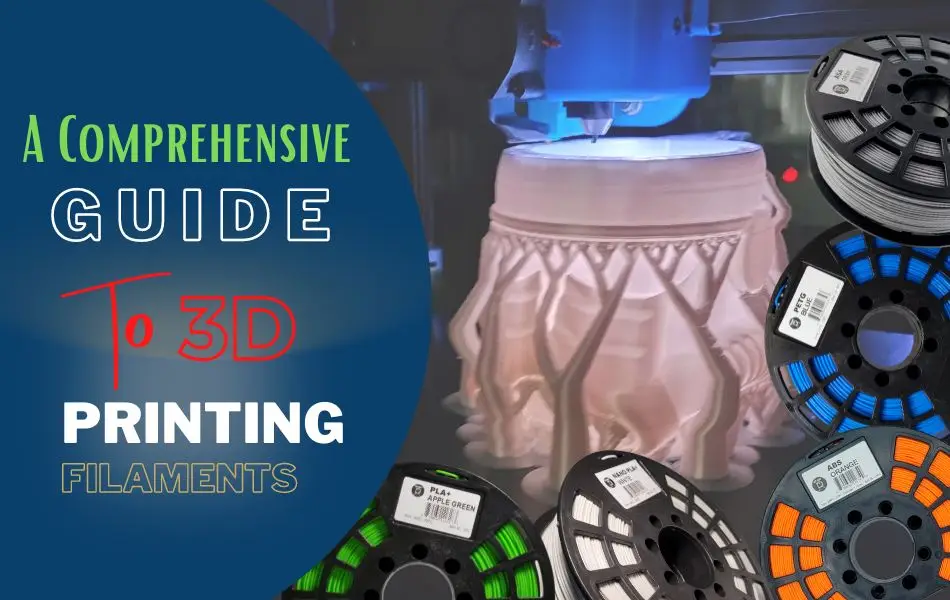3D printing has revolutionized the manufacturing industry by enabling the creation of complex designs with ease. One crucial element of 3D printing is the filament, which is the material used to build physical objects. This post will explore five popular 3D printing filaments: PLA, PETG, ABS, ASA, and nanodiamond-infused PLA. We will delve into their key properties and applications, providing a comprehensive overview.
Let’s dive in!
1 – PLA (Polylactic Acid):
PLA is one of the most widely used 3D printing filaments due to its affordability and ease of use. It is derived from renewable resources such as cornstarch or sugarcane. PLA has low toxicity and emits a sweet aroma when printing. Key properties of PLA include:
- Easy to print: PLA requires lower printing temperatures, making it compatible with a wide range of 3D printers.
- Biodegradable: PLA is environmentally friendly and can break down naturally over time.
- Limited heat resistance: PLA has a low glass transition temperature, which means it may deform under high temperatures.
- Applications: PLA is commonly used for prototyping, educational purposes, artistic prints, and low-stress applications where high-temperature resistance is not required.
2 – PETG (Polyethylene Terephthalate Glycol-Modified):
PETG is a popular filament known for its durability, strength, and flexibility. It offers a balance between ease of use and mechanical properties. Key properties of PETG include:
- Excellent layer adhesion: PETG exhibits strong interlayer bonding, producing robust prints.
- Chemical resistance: This is one of the 3D printing filaments that resist chemicals, including acids and alkalis.
- Good flexibility: PETG has some degree of flexibility, making it suitable for functional prints.
- Applications: PETG is commonly used for mechanical parts, prototypes, protective enclosures, and objects requiring impact resistance and flexibility.
3 – ABS (Acrylonitrile Butadiene Styrene):
ABS is a popular thermoplastic filament known for its strength, durability, and heat resistance. It is commonly used in engineering applications and provides a balance between strength and printability. Key properties of ABS include:
- High-temperature resistance: ABS can withstand higher temperatures compared to PLA.
- Good mechanical properties: ABS exhibits excellent strength, toughness, and impact resistance.
- Requires heated bed and enclosed printer: Due to its tendency to warp, ABS typically requires a heated build platform and an enclosed printer.
- Applications: ABS is great for functional parts, automotive components, electrical enclosures, and prototypes requiring higher temperature resistance.
4 – ASA (Acrylonitrile Styrene Acrylate):
ASA is a filament similar to ABS but with improved weather resistance and UV stability. It is one of the best 3D printing filaments for outdoor applications due to its enhanced durability. Key properties of ASA include:
- UV resistance: ASA is resistant to UV degradation, making it suitable for outdoor use without significant color fading or degradation.
- Good mechanical properties: ASA offers similar mechanical properties to ABS, including strength and impact resistance.
- Requires heated bed and enclosed printer (optional): Like ABS, ASA benefits from a heated build platform and an enclosed printer to minimize warping.
- Applications: ASA is commonly used for outdoor signage, automotive parts, functional prototypes, and objects exposed to sunlight.
5 – Nanodiamond-infused PLA:
Nanodiamond-infused PLA is one of the relatively new 3D printing filaments that combines the benefits of PLA with enhanced mechanical properties. The addition of nanodiamond particles improves strength and stiffness. Key properties of nanodiamond-infused PLA include:
- Increased mechanical strength: The addition of nanodiamonds enhances PLA prints’ overall strength and rigidity.
- Improved heat resistance: Nanodiamonds can improve the heat resistance of PLA, allowing it to withstand higher temperatures.
- Applications: Nanodiamond-infused PLA suits applications requiring high mechanical strength, such as functional prototypes, engineering parts, and lightweight tooling.
Remember that each filament has its unique properties and applications. When selecting a filament for your 3D printing project, consider the specific requirements of your design, such as temperature resistance, strength, flexibility, and desired aesthetics.
Armed with this knowledge, you can confidently choose the perfect filament for your next 3D printing endeavor! Happy 3D printing!
